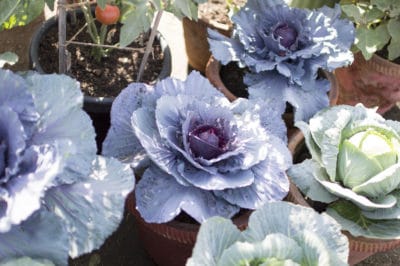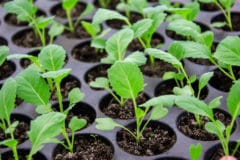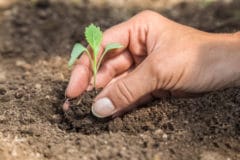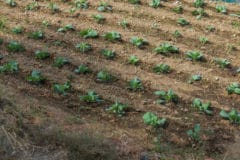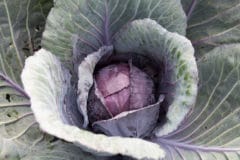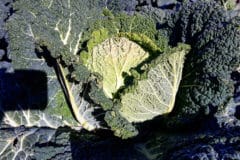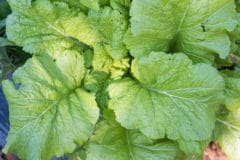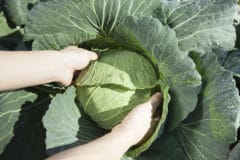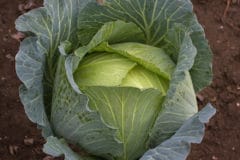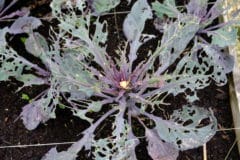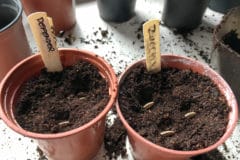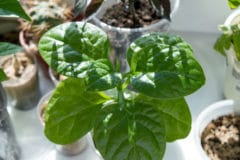Cabbages for Containing in Containers
When deciding on what types of cabbage to choose for your containers, consider the following varieties:
- Savoy King and Savoy Queen produce crinkly green leaves.
- Red Meteor and Ruby Ball are red heads.
- Cheers and King Cole form smooth, green heads.
- Chinese cabbage grows upright, providing a contrast with the round heads of other cabbages.
Containers for Containing Your Cabbage
Your cabbage needs a container that allows enough space for your cabbage to grow, that provides for good drainage, and that has never contained poisons or toxic or hazardous materials. Any container that is at least 12 inches deep and at least 18 inches wide or that allows 18 inches of space per cabbage provides your cabbage with ample space.
The container you choose should have at least one drainage hole in the bottom. If you want to use a container that doesn’t already have one or more holes, you can still use it as long as you can create holes for drainage. The larger the container, the more holes it should have. For example, if you want to plant your cabbage in a bucket, you should make holes in both the bottom and the sides.
You can get creative and use any container that fulfills these fairly simple requirements.
A Time to Sow
You can buy cabbage seedlings, or grow your own, and plant them two to three before the last frost date in your area, or you can plant your seeds directly in your pot two weeks before the last frost date in your area.
If you want to start your own seedlings for transplanting, you should start the seeds six to eight weeks before the last frost date in your area. Placing your seeds under a grow light or a cool white florescent light encourages germination.
If you don’t know the last frost date in your area, contact your local extension service.
A Soil for Sowing
Cabbage draws a large supply of nutrients from the soil. Choose a loamy or sandy potting soil for vegetables or herbs and vegetables and a granulated, slow-release, organic fertilizer with a N-P-K (nitrogen-potassium-phosphate) ratio of 13-13-13 or 14-14-14. Following the directions on the fertilizer package, mix an appropriate amount of fertilizer with the soil.
For aeration and drainage, place two or three stones around the holes in the bottom of your pot, and then fill the pot with the mixture soil and fertilizer.
You should sow the seeds 2 inches apart and cover them with 1/2 inch of soil. Allow the top inch of soil to dry out between each watering. Don’t allow the soil to become muddy, and don’t let water stand on the soil.
A Time for Transplanting
A week or two before you transplant your seedlings, begin hardening them, or acclimating them to the conditions outdoors. Your seedlings should have two or three pairs of leaves, and temperatures should remain steadily around 50°F (10°C). Mature cabbage, however, will grow well at temperatures between 39-75°F (4-24°C). They even survive light frosts.
On the first day, move your seedlings outside for two hours on a cloudy afternoon. The next day, leave them outside for four hours, giving them one hour of morning sunlight. On each successive day, extend the periods of time in the morning sun and the overall time outdoors until, finally, you begin leaving your cabbages outdoors overnight on nights when no hard frost is expected.
When you are ready to transplant your cabbages, dig a hole in your pot deep enough to cover the roots and two inches of the stem. Make sure that the lowest leaves are above the level of the soil.
If you are planting more than one cabbage in a container, leave 12 to 18 inches between them. The amount of space that you leave between your cabbages determines the size of the head.
Companions in the Container
If you would like to include other plants with your cabbage, try natural companion plants such as these:
- Celery, dill, garlic, and onions enhance the flavor of your cabbage.
- Marigolds, rosemary, tansy, and thyme repel cabbage pests like the imported white cabbage moth, cabbageworms, and cutworms.
- Yarrow adds nutrients to the soil and also repels pests.
Cauliflower and broccoli are closely related to cabbage, and they attract the same pests. Also, like cabbage, they, too, draw large amounts of nutrients from the soil. So, these three vegetables should never share the same container.
A Time for Caring for Cabbage
Watering cabbage evenly helps the heads to fill out evenly, but overwatering results in growth spurts that causes the heads to split. Water your cabbage until you see water beginning to emerge from the drainage holes in the pot, and then check your cabbage daily by sticking your finger into the soil. When the top 1 inch of soil feels dry, water your cabbage again.
When the heads begin to form, feed your cabbage with an organic, water-soluble fertilizer with a 20-20-20 ratio, following the package directions.
Cabbage prefers full sun, but during periods of high heat, move your cabbage into a cooler, partly shaded area.
A Time to Reap
When the heads on your cabbage feel firm and solid when you squeeze them, they are ready to harvest. With a sharp knife, cut the cabbage from the stalk near the base of the head. If you leave the roots and outer leaves in the pot, new, smaller heads will form. Pinch off all but four of these, and let them grow until they are about the size of tennis balls before harvesting them.
After this second harvest, remove the stem and roots from the pot to avoid attracting pests or diseases.
Cabbage leaves can be stored in a plastic bag in your refrigerator for about two weeks, but cabbage heads can be kept in root cellar conditions for up to three months.
As long as your cabbages are free of disease and pests, you can reuse the soil and the pot, but, again, to avoid attracting diseases or pests, you should rotate your plants and avoid using that pot for cabbage or its near relatives – kale, collards, Brussels sprouts, and broccoli – for the next two years.
